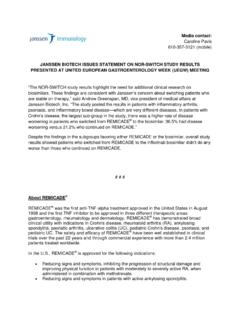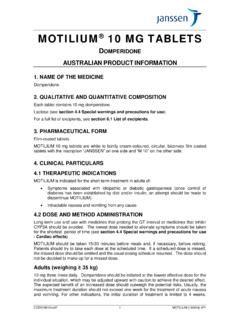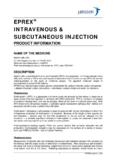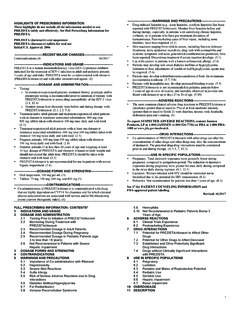Transcription of About XEPLION - Janssen
1 About XEPLION What is XEPLION ? XEPLION (paliperidone palmitate) is a once-monthly, long-acting antipsychotic medication, approved in Europe for the treatment of Long-acting treatments such as XEPLION can help people with schizophrenia to maintain continuous treatment, control their symptoms and help reduce the risk of 7 This enables people with the condition to focus on shaping their future and live as normal a life as possible, which may include returning to work or study, independent living and social relationships. How XEPLION works It is generally accepted that the symptoms of schizophrenia, such as hallucinations, delusions, lack of emotional response, social withdrawal/depression, apathy and a lack of drive or initiative are mainly caused by abnormalities in the activity of two particular neurotransmitters in the brain, dopamine and serotonin.
2 XEPLION targets dopamine and serotonin receptors to reduce the symptoms of Efficacy Efficacy was apparent early during double-blind therapy, with statistical superiority of both paliperidone palmitate groups relative to placebo achieved by day 8 in the treatment of schizophrenia o XEPLION showed significant improvements in symptoms as early as day 8 of treatment compared to placebo as measured using the Positive and Negative Syndrome Scale (PANSS) without the need for additional oral antipsychotic medication3,4* o The PANSS is a measure which healthcare professionals use to assess the symptomatic change in the severity of schizophrenia Treatment with XEPLION was superior to placebo at improving patients ability to engage in personal and social life activities, as measured using the Personal and Social Performance Scale (PSP)3,5 Flexible maintenance dosing with XEPLION in patients with schizophrenia who are responsive to oral paliperidone or risperidone is associated with a clinically relevant treatment response, and is well tolerated (in a large, 6-month, international clinical study designed to more closely resemble clinical practice).
3 9,10 Furthermore, in a recent study, treatment with XEPLION resulted in clinically relevant responses specifically in patients recently diagnosed with schizophrenia ( 3 years)11 XEPLION also showed a significant reduction in the risk of relapse compared to placebo5,6 and, in a recent study, other oral antipsychotic treatments7 The reduction in symptoms and improvement in ability to engage in everyday activities observed with XEPLION were maintained in the longer term6 Safety profile XEPLION is generally well ,6 In clinical studies XEPLION was associated with movement disorders and significant weight gain. Tissue culture studies suggest that cell growth in human breast tumours may be stimulated by prolactin. Although no clear association with the administration of antipsychotics has so far been demonstrated in clinical and epidemiological studies, caution is recommended in patients with relevant medical history.
4 Paliperidone should be used with caution in patients with possible prolactin-dependent tumours. In clinical trials, median increases in serum prolactin were observed in subjects of both genders who received XEPLION . Adverse reactions that may suggest increase in prolactin levels ( amenorrhoea, galactorrhoea, menstrual disturbances, gynaecomastia) were reported overall in < 1% of ,3 The ADRs most frequently reported in clinical trials were insomnia, headache, anxiety, upper respiratory tract infection, injection site reaction, parkinsonism, weight increase, akathisia, agitation, sedation/somnolence, nausea, constipation, dizziness, musculoskeletal pain, tachycardia, tremor, abdominal pain, vomiting, diarrhoea, fatigue, and dystonia1 As paliperidone is the active metabolite of risperidone, other ADRs particular to risperidone may be expected to occur with XEPLION please refer to the Summary of Product Characteristics (SmPC)
5 For the full list of ADRs1 Administration The recommended initiation of XEPLION is with a dose of 150 mg on treatment day 1 and 100 mg one week later (day 8), both administered in the deltoid muscle (arm) in order to attain therapeutic concentrations rapidly. The third dose should be administered one month after the second initiation dose. The recommended monthly maintenance dose is 75 mg; some patients may benefit from lower or higher doses within the recommended range of 25 to 150 mg based on individual patient tolerability and/or efficacy. Patients who are overweight or obese may require doses in the upper range. Following the second initiation dose, monthly maintenance doses can be administered in either the deltoid or gluteal muscle, so the patient can choose which site they ,2 For more information XEPLION is indicated for maintenance treatment of schizophrenia in adult patients stabilised with paliperidone or risperidone.
6 In selected adult patients with schizophrenia and previous responsiveness to oral paliperidone or risperidone, XEPLION may be used without prior stabilisation with oral treatment if psychotic symptoms are mild to moderate and a long-acting injectable treatment is needed. *Following initiation with 150 mg eq . on day 1 as per the licence recommendations. References 1. Summary of Product Characteristics XEPLION 25 mg, 50 mg, 75 mg, 100 mg and 150 mg prolonged release suspension for injection. Janssen -Cilag. Last updated July 2015. 2. Kane JM. Treatment adherence and long term outcomes. CNS Spectr 2007;12:10(Suppl. 17):21 26. 3. Pandina GJ, Lindenmayer JP, Lull J, et al. A randomized, placebo-controlled study to assess the efficacy and safety of 3 doses of paliperidone palmitate in adults with acutely exacerbated schizophrenia.
7 J Clin Psychopharmacol 2010;30:235 244. 4. Bossie CA, Sliwa JK, Ma YW, et al. Onset of efficacy and tolerability following the initiation dosing of long-acting paliperidone palmitate: post-hoc analyses of a randomized, double-blind clinical trial. BMC Psychiatry 2011;11:79. 5. Hough D, Gopal S, Vijapurkar U, et al. Paliperidone palmitate maintenance treatment in delaying the time-to-relapse in patients with schizophrenia: a randomized, double-blind, placebo-controlled study. Schizophr Res 2010;116:107 117. 6. Gopal S, Vijapurkar U, Lim P, et al. A 52-week open-label study of the safety and tolerability of paliperidone palmitate in patients with schizophrenia. J Psychopharmacol 2011;25:685 697. 7. Schreiner A, Aadamsoo K, Altamura C, et al.
8 A randomized, active-controlled rater-blinded 2-year study of paliperidone palmitate versus investigators' choice of oral antipsychotic monotherapy in patients with schizophrenia (PROSIPAL) [Poster 61]. Presented at The 22nd European Congress of Psychiatry, Munich, Germany, 1-4 March 2014. 8. Fowler JA, Bettinger TL, Argo TR. Paliperidone extended-release tablets for the acute and maintenance treatment of schizophrenia. Clin Ther 2008;30:231 248. 9. Schreiner A, Bergmans P, Cherubin P, et al. A prospective flexible-dose study of paliperidone palmitate in nonacute but symptomatic patients with schizophrenia previously unsuccessfully treated with oral antipsychotic agents. Clin Ther 2014;36:1372 1388. 10. Hargarter L, Cherubin P, Bergmans P, et al.
9 Intramuscular long-acting paliperidone palmitate in acute patients with schizophrenia unsuccessfully treated with oral antipsychotics. Prog Neuropsychopharmacol Biol Psychiatry 2015;58:1 7. 11. Hargarter L, Bergmans P, Cherubin P, et al. Once-monthly paliperidone palmitate Tolerability and treatment response in recently diagnosed versus chronic non-acute schizophrenia patients switched from previously unsuccessful treatment with oral antipsychotics [Poster 40]. Presented at the The 22nd European Congress of Psychiatry, Munich, Germany, 1 4 March 2014.













